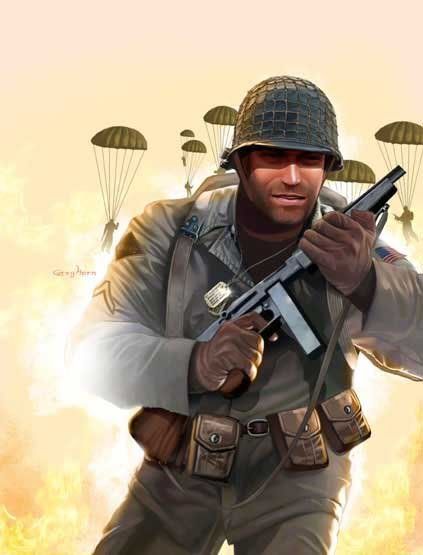Post by DarkClown on Apr 9, 2005 14:07:54 GMT 1
I thought i could make a post about that because our ranks are close to the ones in the US army:
Enlistend Soldier classes:
Private (PVT/PV2)

Lowest rank: a trainee who’s starting Basic Combat Training (BCT). Primary role is to carry out orders issued to them to the best of his/her ability. (PVT does not have an insignia)
PRIVATE FIRST CLASS (PFC)

PV2s are promoted to this level after one year—or earlier by request of supervisor. Individual can begin BCT at this level with experience or prior military training. Carries out orders issued to them to the best of his/her ability.
SPECIALIST (SPC)

Can manage other enlisted Soldiers of lower rank. Has served a minimum of two years and attended a specific training class to earn this promotion. People enlisting with a four year college degree can enter BCT as a Specialist.
CORPORAL (CPL)

The base of the Non-Commissioned Officer (NCO) ranks, CPLs serve as team leader of the smallest Army units. Like SGTs, they are responsible for individual training, personal appearance and cleanliness of Soldiers.
SERGEANT (SGT)

Typically commands a squad (9 to 10 Soldiers). Considered to have the greatest impact on Soldiers because SGTs oversee them in their daily tasks. In short, SGTs set an example and the standard for Privates to look up to, and live up to.
STAFF SERGEANT (SSG)

Also commands a squad (9 to 10 Soldiers). Often has one or more SGTs under their leadership. Responsible for developing, maintaining and utilizing the full range of his Soldiers' potential.
SERGEANT FIRST CLASS (SFC)

Key assistant and advisor to the platoon leader. Generally has 15 to 18 years of Army experience and puts it to use by making quick, accurate decisions in the best interests of the Soldiers and the country.
MASTER SERGEANT (MSG)

Principal NCO at the battalion level, and often higher. Not charged with all the leadership responsibilities of a 1SG, but expected to dispatch leadership and other duties with the same professionalism.
FIRST SERGEANT (1SG)

Principal NCO and life-blood of the company: the provider, disciplinarian and wise counselor. Instructs other SGTs, advises the Commander and helps train all enlisted Soldiers. Assists Officers at the company level (62 to 190 Soldiers).
SERGEANT MAJOR (SGM)

SGMs experience and abilities are equal to that of the CSM, but the sphere of influence regarding leadership is generally limited to those directly under his charge. Assists Officers at the battalion level (300 to 1,000 Soldiers).
COMMAND SERGEANT MAJOR (CSM)

Functioning without supervision, a CSM’s counsel is expected to be calm, settled and accurate—with unflagging enthusiasm. Supplies recommendations to the commander and staff, and carries out policies and standards on the performance, training, appearance and conduct of enlisted personnel. Assists Officers at the brigade level (3,000 to 5,000 Soldiers).
SERGEANT MAJOR OF THE ARMY

There’s only one Sergeant Major of the Army. This rank is the epitome of what it means to be a Sergeant and oversees all Non-Commissioned Officers. Serves as the senior enlisted advisor and consultant to the Chief of Staff of the Army (a four-star General).
Enlistend Soldier classes:
Private (PVT/PV2)

Lowest rank: a trainee who’s starting Basic Combat Training (BCT). Primary role is to carry out orders issued to them to the best of his/her ability. (PVT does not have an insignia)
PRIVATE FIRST CLASS (PFC)

PV2s are promoted to this level after one year—or earlier by request of supervisor. Individual can begin BCT at this level with experience or prior military training. Carries out orders issued to them to the best of his/her ability.
SPECIALIST (SPC)

Can manage other enlisted Soldiers of lower rank. Has served a minimum of two years and attended a specific training class to earn this promotion. People enlisting with a four year college degree can enter BCT as a Specialist.
CORPORAL (CPL)

The base of the Non-Commissioned Officer (NCO) ranks, CPLs serve as team leader of the smallest Army units. Like SGTs, they are responsible for individual training, personal appearance and cleanliness of Soldiers.
SERGEANT (SGT)

Typically commands a squad (9 to 10 Soldiers). Considered to have the greatest impact on Soldiers because SGTs oversee them in their daily tasks. In short, SGTs set an example and the standard for Privates to look up to, and live up to.
STAFF SERGEANT (SSG)

Also commands a squad (9 to 10 Soldiers). Often has one or more SGTs under their leadership. Responsible for developing, maintaining and utilizing the full range of his Soldiers' potential.
SERGEANT FIRST CLASS (SFC)

Key assistant and advisor to the platoon leader. Generally has 15 to 18 years of Army experience and puts it to use by making quick, accurate decisions in the best interests of the Soldiers and the country.
MASTER SERGEANT (MSG)

Principal NCO at the battalion level, and often higher. Not charged with all the leadership responsibilities of a 1SG, but expected to dispatch leadership and other duties with the same professionalism.
FIRST SERGEANT (1SG)

Principal NCO and life-blood of the company: the provider, disciplinarian and wise counselor. Instructs other SGTs, advises the Commander and helps train all enlisted Soldiers. Assists Officers at the company level (62 to 190 Soldiers).
SERGEANT MAJOR (SGM)

SGMs experience and abilities are equal to that of the CSM, but the sphere of influence regarding leadership is generally limited to those directly under his charge. Assists Officers at the battalion level (300 to 1,000 Soldiers).
COMMAND SERGEANT MAJOR (CSM)

Functioning without supervision, a CSM’s counsel is expected to be calm, settled and accurate—with unflagging enthusiasm. Supplies recommendations to the commander and staff, and carries out policies and standards on the performance, training, appearance and conduct of enlisted personnel. Assists Officers at the brigade level (3,000 to 5,000 Soldiers).
SERGEANT MAJOR OF THE ARMY

There’s only one Sergeant Major of the Army. This rank is the epitome of what it means to be a Sergeant and oversees all Non-Commissioned Officers. Serves as the senior enlisted advisor and consultant to the Chief of Staff of the Army (a four-star General).





































